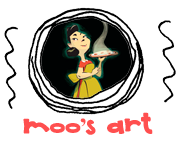 A Tale of 12 Kitchens: Family Cooking in Four Countries by Jake Tilson
A Tale of 12 Kitchens: Family Cooking in Four Countries by Jake Tilson . This isn't your normal cookbook, which is what caught my interest. The page layouts look like a scrapbook, but not the kind on display in Michaels or Joanns. This is an unexpected, unique style of collage: there are pictures of packages, menus, kitchens, paraphernalia from the towns where the recipes are eaten, random things like president shaped cookie cutters...I can't do it justice here. The book is worth looking at just to enjoy the layouts. One of my favorite sections is the New York section, in which the author tells how he wanders through the city for Breakfast No. 1 at 6am (in the bitter cold) then treks around the city till his wife joins him for breakfast No. 2, then plans to have breakfast No. 3 two hours after that. That is my kind of itinerary. That page features a menu graphic of two little birds chirping "Good Morning Breakfast Menu," a picture of a diner on a winter day, a plastic toothpick sword, and a full page picture of pancakes on the page opposite. It's charming! The author details his love affair with food in four different countries by recounting the memories he associates with the food along with the stories of the people who supply the recipes included. I'm not nearly cosmopolitan enough to appreciate most of the included recipes--they are regional and mostly unfamiliar foods. The ones I plan to try: Pancake Laboratory (substitute oj for milk and I'd try the snowcakes if it would snow again here); Skirlie (scottish oatmeal cooked with onions); and Don't Go to Any Trouble Backstreet Couscous.
. This isn't your normal cookbook, which is what caught my interest. The page layouts look like a scrapbook, but not the kind on display in Michaels or Joanns. This is an unexpected, unique style of collage: there are pictures of packages, menus, kitchens, paraphernalia from the towns where the recipes are eaten, random things like president shaped cookie cutters...I can't do it justice here. The book is worth looking at just to enjoy the layouts. One of my favorite sections is the New York section, in which the author tells how he wanders through the city for Breakfast No. 1 at 6am (in the bitter cold) then treks around the city till his wife joins him for breakfast No. 2, then plans to have breakfast No. 3 two hours after that. That is my kind of itinerary. That page features a menu graphic of two little birds chirping "Good Morning Breakfast Menu," a picture of a diner on a winter day, a plastic toothpick sword, and a full page picture of pancakes on the page opposite. It's charming! The author details his love affair with food in four different countries by recounting the memories he associates with the food along with the stories of the people who supply the recipes included. I'm not nearly cosmopolitan enough to appreciate most of the included recipes--they are regional and mostly unfamiliar foods. The ones I plan to try: Pancake Laboratory (substitute oj for milk and I'd try the snowcakes if it would snow again here); Skirlie (scottish oatmeal cooked with onions); and Don't Go to Any Trouble Backstreet Couscous.  Mama Makes Up Her Mind by Bailey White. My dad loves reading Bailey White; he donates his books to me when he's finished reading them, so I gave this one a whirl.
Mama Makes Up Her Mind by Bailey White. My dad loves reading Bailey White; he donates his books to me when he's finished reading them, so I gave this one a whirl.Ms. White relates anecdotes from her life, her mother's life, her aunt's life...by the time I read all of the stories, I realized how different my life is from hers. I don't have a screened porch with a bathtub that empties onto a bed of lilies. I don't have a pond full of alligators (which, may not be lamentable), and I don't have a mother who eats road kill (also, probably not lamentable). In spite of the differences, I was left with a feeling that, somehow, I do relate to her life.
I love this book because the stories are short and funny. I love the simple style, the way she laughs at people's quirks without being cruel, and I love the perspective the stories encourage. I kept thinking, there's so much to appreciate and enjoy in regular life. My favorite part? The fact that she uses sea chanties to teach first graders to read. "Give me a man overboard or a good sinking ship, and I can teach a half-witted gorilla to read."
 The Traveler by John Twelve Hawks
The Traveler by John Twelve HawksThis isn’t my normal novel (although my town library has classified this as a Young Adult book, I would keep it in the adult section), so heads up. It was violent (it’s more violent in parts than the Jason Bourne movies, so if you didn’t like them, don’t go near this).
I didn’t like the book, although I’m glad my complaints come from another angle than I was expecting.
It was cliché—the seedy contacts that were used to gain false ids, the bad guys, the sidekicks, even the descriptions of alternate realities—cliché. Maybe that isn’t the author’s fault, maybe this book generated spinoff tv shows or movies or books that got to me first. But, I’m skeptical.
Another complaint. The author dished a fairly intricate plot and then wrapped everything up in under twenty pages. I’m supposed to believe that the thing the characters considered to be an impossible task actually was that impossible when it only took a few pages to get through it? I was more focused on how few pages there were left in the book than in the ending itself. I kept thinking, “There can only be three or four pages left. That isn’t enough to do the plot justice.” At that point, I knew it was going to be a lousy conclusion. And it’s not the kind of ending where I was so excited knowing that there was a sequel coming to keep the story going. No. It was more like, “I can’t believe I wasted all of that time plowing through the story only to have a cheap ending.” So, I read a plot summary on Wikipedia, and confirmed that the next book is even more silly than this one.
 Into the Wildewood by Gillian Summers. The cover is deceiving. It gives one the impression that possibly, this won't be a totally ridiculous book. It's a fifteen year old girl who is an elf living in the human world. She and her father travel to different Renaissance Fairs to make money selling furniture. It has the potential to be an interesting plot--an elf girl who can talk to trees, distraught trees in need of someone to save them. Then, a unicorn steps on the scene. I was prepared to play along, elves, talking trees...why not a unicorn too. But, it didn't improve. The plot dragged on and also came up at random moments (e.g. girl is in precarious situation at work and suddenly, in the middle of the work drama feels compelled to find out what a tree is thinking. Just because.), and was eventually resolved in a way that every teenage girl would want it to be.
Into the Wildewood by Gillian Summers. The cover is deceiving. It gives one the impression that possibly, this won't be a totally ridiculous book. It's a fifteen year old girl who is an elf living in the human world. She and her father travel to different Renaissance Fairs to make money selling furniture. It has the potential to be an interesting plot--an elf girl who can talk to trees, distraught trees in need of someone to save them. Then, a unicorn steps on the scene. I was prepared to play along, elves, talking trees...why not a unicorn too. But, it didn't improve. The plot dragged on and also came up at random moments (e.g. girl is in precarious situation at work and suddenly, in the middle of the work drama feels compelled to find out what a tree is thinking. Just because.), and was eventually resolved in a way that every teenage girl would want it to be.  Tales from Shakespeare by Tina Packer. This is a beautifully illustrated collection of summaries of the plots of 12 Shakespeare plays. I enjoyed it immensely. I've read and seen most of the plays. I've analyzed them, written papers about them, even memorized lines from them. I haven't ever taken the time to simply enjoy the story and appreciate the plays for what they are: interesting stories. They are sometimes silly, many times improbable, and yet, they are compelling. These summaries give you a chance to appreciate the plots without getting bogged down in the language (I know, not a very scholarly or sophisticated approach, and blasphemy to some). I would love to read these with middle school kids. Then, I would feel comfortable taking the students into the original text because they would have an idea of the overall story to back them up through the difficult reading. It's also a great refresher if you need to brush up on Shakespeare.
Tales from Shakespeare by Tina Packer. This is a beautifully illustrated collection of summaries of the plots of 12 Shakespeare plays. I enjoyed it immensely. I've read and seen most of the plays. I've analyzed them, written papers about them, even memorized lines from them. I haven't ever taken the time to simply enjoy the story and appreciate the plays for what they are: interesting stories. They are sometimes silly, many times improbable, and yet, they are compelling. These summaries give you a chance to appreciate the plots without getting bogged down in the language (I know, not a very scholarly or sophisticated approach, and blasphemy to some). I would love to read these with middle school kids. Then, I would feel comfortable taking the students into the original text because they would have an idea of the overall story to back them up through the difficult reading. It's also a great refresher if you need to brush up on Shakespeare. The Owl Service by Alan Garner. This is an older book (published in the sixties); I found it in the little town library and took it home out of curiosity. It is a fantasy based on a Celtic myth--and it's a little strange. The author twists the scenes and the dialogue leaving the reader to make assumptions about what has occurred. The slang is dated and is difficult to interpret at times (maybe a Brit would have an easier go at it). At some point I realized that this novel would have been more effective as a movie--I think the audience would follow the character's emotions better, and the setting wouldn't be so confusing. It's not particularly a happy book--it's a myth, not a modernized fairy tale. It has received some prestigious awards. Maybe I'm suffering from a lack of literary appreciation, but I don't intend to read it again.
The Owl Service by Alan Garner. This is an older book (published in the sixties); I found it in the little town library and took it home out of curiosity. It is a fantasy based on a Celtic myth--and it's a little strange. The author twists the scenes and the dialogue leaving the reader to make assumptions about what has occurred. The slang is dated and is difficult to interpret at times (maybe a Brit would have an easier go at it). At some point I realized that this novel would have been more effective as a movie--I think the audience would follow the character's emotions better, and the setting wouldn't be so confusing. It's not particularly a happy book--it's a myth, not a modernized fairy tale. It has received some prestigious awards. Maybe I'm suffering from a lack of literary appreciation, but I don't intend to read it again. Ivy and Bean and the Ghost That Had To Go by Annie Barrows, Illustrated by Sophie Blackall. I liked this book. I really liked this book. It's funny, it's genuine, it's...well, it's second grade. Made me want to go back for a few days. The illustrations made me laugh and fall in love with the characters (and made me want Bean's octopus shirt!). This is "chapter book" that was actually enjoyable to read. Usually, I loathe early reader types. I plan to read more. The two main characters, Ivy and Bean, determine there is a ghost haunting the girl's bathroom and come up with a plan to get rid of the ghost. Of course, the plan they come up with is totally silly. I'm looking forward to reading the next one.
Ivy and Bean and the Ghost That Had To Go by Annie Barrows, Illustrated by Sophie Blackall. I liked this book. I really liked this book. It's funny, it's genuine, it's...well, it's second grade. Made me want to go back for a few days. The illustrations made me laugh and fall in love with the characters (and made me want Bean's octopus shirt!). This is "chapter book" that was actually enjoyable to read. Usually, I loathe early reader types. I plan to read more. The two main characters, Ivy and Bean, determine there is a ghost haunting the girl's bathroom and come up with a plan to get rid of the ghost. Of course, the plan they come up with is totally silly. I'm looking forward to reading the next one. As The City Sleeps by Stephen T. Johnson.
As The City Sleeps by Stephen T. Johnson.This isn't really a "story" book. It's a compilation of "pictures" of a city at night. Each picture has a caption that hints at the story behind the picture. And all of the pictures are designed to spark your imagination. What is that running through the city? Why is that cab moving without a driver?
It reminds me of Chris Van Allsburg's book The Mysteries of Harris Burdick. Every so often, my sixth grade teacher would choose a picture from that book, and we used it and it's caption as the starting point for a creative writing assignment. As the City Sleeps would be perfect for that kind of exercise. It's a little spooky too, which is sure to get kids interested.
 Bread and Jam for Frances by Russell Hoban, illustrated by Lillian Hoban
Bread and Jam for Frances by Russell Hoban, illustrated by Lillian HobanI haven't read this book since I was a child. I had forgotten the plot, but the illustrations all seemed familiar. In short: I loved it. It's the story of a little badger, Frances, who only wants to eat bread and jam. It's actually funny. And the story is better than typical "I don't want to eat food" kinds of books. One of my favorite things about it is how Frances sings little songs to and about her food. I thought I was the only one!





1 comment:
Thanks for the book list. Using As the City Sleeps as a prompt for creative writing is such a neat idea.
Post a Comment